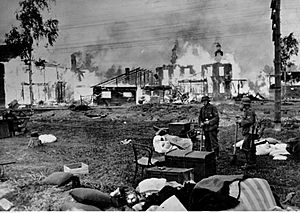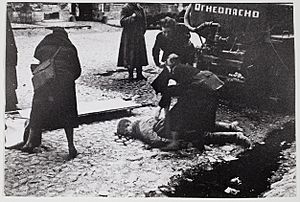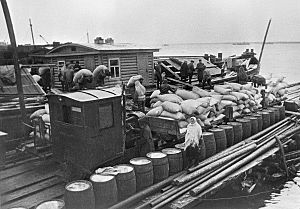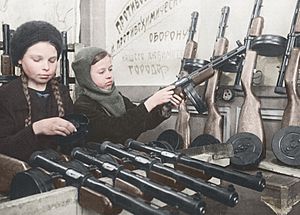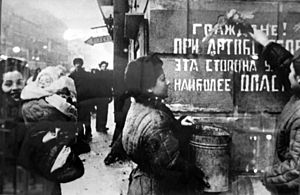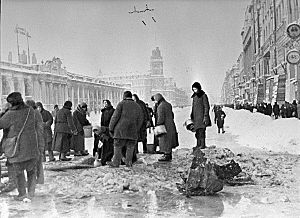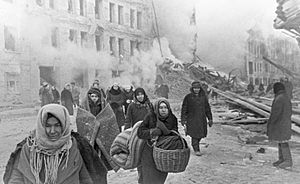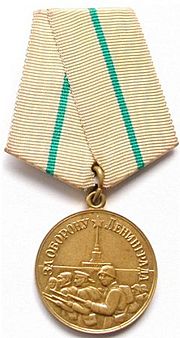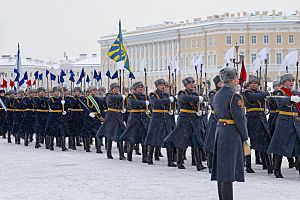Siege of Leningrad facts for kids
The Siege of Leningrad, also known as the Leningrad Blockade, was a siege in Leningrad during World War II. The siege started on 8 September 1941, when the last road to the city was severed. Although the Soviet Union forces managed to open a narrow path to the city on 18 January 1943, the siege was only stopped on 27 January 1944, 872 days after it began. The blockade became one of the longest and most destructive sieges in history, and it was possibly the costliest siege in history due to the number of casualties which were suffered throughout its duration. An estimated 1.5 million people died as a result of the siege.
Because of the German operations, no people or supply trucks were allowed to enter or leave the city, leaving the occupants without food often for weeks or months.
Contents
Background
Leningrad's capture was one of three strategic goals in the German Operation Barbarossa and the main target of Army Group North. The strategy was motivated by Leningrad's political status as the former capital of Russia and the symbolic capital of the Russian Revolution and Bolshevism hated by the Nazi Party, the city's military importance as a main base of the Soviet Baltic Fleet, and its industrial strength, including its numerous arms factories. In 1939, the city was responsible for 11% of all Soviet industrial output.
It has been said that Adolf Hitler was so confident of capturing Leningrad that he had invitations printed to the victory celebrations to be held in the city's Hotel Astoria.
Although various theories have been put forward about Germany's plans for Leningrad, including making it the capital of the new Ingermanland province of the Reich in Generalplan Ost, it is clear Hitler intended to utterly destroy the city and its population. According to a directive sent to Army Group North on 29 September:
After the defeat of Soviet Russia there can be no interest in the continued existence of this large urban center. [...] Following the city's encirclement, requests for surrender negotiations shall be denied, since the problem of relocating and feeding the population cannot and should not be solved by us. In this war for our very existence, we can have no interest in maintaining even a part of this very large urban population.
Hitler's ultimate plan was to raze Leningrad and give areas north of the River Neva to the Finns.
Defensive operations
The Leningrad Front (initially the Leningrad Military District) was commanded by Marshal Kliment Voroshilov. It included the 23rd Army in the northern sector between the Gulf of Finland and Lake Ladoga, and the 48th Army in the western sector between the Gulf of Finland and the Slutsk–Mga position. The Leningrad Fortified Region, the Leningrad garrison, the Baltic Fleet forces, and Koporye, Pulkovo, and Slutsk–Kolpino operational groups were also present.
Defence of civilian evacuees
According to Zhukov, "Before the war Leningrad had a population of 3,103,000 and 3,385,000 counting the suburbs. As many as 1,743,129, including 414,148 children were evacuated" between 29 June 1941 and 31 March 1943. They were moved to the Volga area, the Urals, Siberia and Kazakhstan.
By September 1941, the link with the Volkhov Front (commanded by Kirill Meretskov) was severed and the defensive sectors were held by four armies: 23rd Army in the northern sector, 42nd Army on the western sector, 55th Army on the southern sector, and the 67th Army on the eastern sector. The 8th Army of the Volkhov Front had the responsibility of maintaining the logistic route to the city in coordination with the Ladoga Flotilla. Air cover for the city was provided by the Leningrad military district PVO Corps and Baltic Fleet naval aviation units.
The defensive operation to protect the 1,400,000 civilian evacuees was part of the Leningrad counter-siege operations under the command of Andrei Zhdanov, Kliment Voroshilov, and Aleksei Kuznetsov. Additional military operations were carried out in coordination with Baltic Fleet naval forces under the general command of Admiral Vladimir Tributs. The Ladoga Flotilla under the command of V. Baranovsky, S.V. Zemlyanichenko, P.A. Traynin, and B.V. Khoroshikhin also played a major military role in helping with evacuation of the civilians.
Bombardment
The first success of the Leningrad air defence took place on the night of 23 June. The Ju-88A bomber from the 1st air corps KGr.806 was damaged by the AA guns fire of the 15th battery of the 192nd anti-aircraft artillery regiment, and made an emergency landing. All crew members, including commander, Lieutenant Hans Turmeyer, were captured on the ground. The commander of the 15th battery, lieutenant, Alexey Pimchenkov was awarded the Order of the Red Banner.
By Monday, 8 September, German forces had largely surrounded the city, cutting off all supply routes to Leningrad and its suburbs. Unable to press home their offensive, and facing defences of the city organised by Marshal Zhukov, the Axis armies laid siege to the city for "900 days and nights".
The air attack of Friday, 19 September, was particularly brutal. It was the heaviest air raid Leningrad would suffer during the war, as 276 German bombers hit the city killing 1,000 civilians. Many of those killed were recuperating from battle wounds in hospitals that were hit by German bombs. Six air raids occurred that day. Five hospitals were damaged in the bombing, as well as the city's largest shopping bazaar. Hundreds of people had run from the street into the store to take shelter from the air raid.
Artillery bombardment of Leningrad began in August, increasing in intensity during 1942 with the arrival of new equipment. It was stepped up further during 1943, when several times as many shells and bombs were used as in the year before. Against this, the Soviet Baltic Fleet Navy aviation made over 100,000 air missions to support their military operations during the siege. German shelling and bombing killed 5,723 and wounded 20,507 civilians in Leningrad during the siege.
Supplying the defenders
To sustain the defence of the city, it was vitally important for the Red Army to establish a route for bringing a constant flow of supplies into Leningrad. This route, which became known as the Road of Life (Russian: Дорога жизни), was effected over the southern part of Lake Ladoga and the corridor of land which remained unoccupied by Axis forces between Lake Ladoga and Leningrad. Transport across Lake Ladoga was achieved by means of watercraft during the warmer months and land vehicles driven over thick ice in winter (hence the route becoming known as "The Ice Road"). The security of the supply route was ensured by the Ladoga Flotilla, the Leningrad PVO Corps, and route security troops. Vital food supplies were thus transported to the village of Osinovets, from where they were transferred and transported over 45 km (28 mi) via a small suburban railway to Leningrad. The route had to be used also to evacuate civilians, since no evacuation plans had been executed in the chaos of the first winter of the war, and the city was completely isolated until 20 November, when the ice road over Lake Ladoga became operational. Vehicles risked becoming stuck in the snow or sinking through broken ice caused by constant German bombardments, but the road brought necessary military and food supplies in and took civilians and wounded soldiers out, allowing the city to continue resisting the enemy.
Effect on the city
The two-and-a-half-year siege caused the greatest destruction and the largest loss of life ever known in a modern city. On Hitler's direct orders the Wehrmacht looted and then destroyed most of the imperial palaces, such as the Catherine Palace, Peterhof Palace, Ropsha, Strelna, Gatchina, and other historic landmarks located outside the city's defensive perimeter, with many art collections transported to Germany. A number of factories, schools, hospitals and other civil infrastructure were destroyed by air raids and long range artillery bombardment.
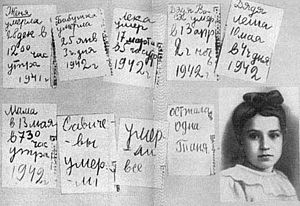
The 872 days of the siege caused extreme famine in the Leningrad region through disruption of utilities, water, energy and food supplies. This resulted in the deaths of up to 1,500,000 soldiers and civilians and the evacuation of 1,400,000 more (mainly women and children), many of whom died during evacuation due to starvation and bombardment. Piskaryovskoye Memorial Cemetery in Leningrad holds half a million civilian victims of the siege alone. Economic destruction and human losses in Leningrad on both sides exceeded those of the Battle of Stalingrad, the Battle of Moscow, or the bombing of Tokyo. The siege of Leningrad ranks as the most lethal siege in world history, and some historians speak of the siege operations in terms of genocide, as a "racially motivated starvation policy" that became an integral part of the unprecedented German war of extermination against populations of the Soviet Union generally.
Civilians in the city suffered from extreme starvation, especially in the winter of 1941–42. From November 1941 to February 1942 the only food available to the citizen was 125 grams of bread per day, of which 50–60% consisted of sawdust and other inedible admixtures. In conditions of extreme temperatures (down to −30 °C (−22 °F)), and with city transport out of service, even a distance of a few kilometres to a food distribution kiosk created an insurmountable obstacle for many citizens. Deaths peaked in January–February 1942 at 100,000 per month, mostly from starvation. People often died on the streets, and citizens soon became accustomed to the sight of death.
Soviet relief of the siege
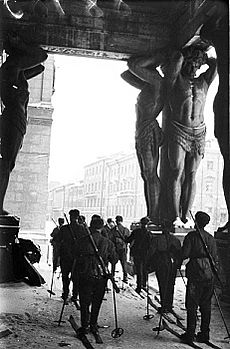
On 9 August 1942, the Symphony No. 7 "Leningrad" by Dmitri Shostakovich was performed by the Leningrad Radio Orchestra. The concert was broadcast on loudspeakers placed throughout the city and also aimed towards the enemy lines. The same day had been previously designated by Hitler to celebrate the fall of the city with a lavish banquet at Leningrad's Astoria Hotel, and was a few days before the Sinyavino Offensive.
Sinyavino Offensive
The Sinyavino Offensive was a Soviet attempt to break the blockade of the city in early autumn 1942. The 2nd Shock and the 8th armies were to link up with the forces of the Leningrad Front. At the same time the German side was preparing an offensive to capture the city, Operation Nordlicht (Northern Light), using the troops made available by the capture of Sevastopol. Neither side was aware of the other's intentions until the battle started.
The offensive began on 27 August 1942 with some small-scale attacks by the Leningrad front, pre-empting "Nordlicht" by a few weeks. The successful start of the operation forced the Germans to redirect troops from the planned "Nordlicht" to counterattack the Soviet armies. The counteroffensive saw the first deployment of the Tiger tank, though with limited success. After parts of the 2nd Shock Army were encircled and destroyed, the Soviet offensive was halted. However, the German forces also had to abandon their offensive.
Operation Iskra
The encirclement was broken in the wake of Operation Iskra (Spark), a full-scale offensive conducted by the Leningrad and Volkhov Fronts. This offensive started in the morning of 12 January 1943. After fierce battles the Red Army units overcame the powerful German fortifications to the south of Lake Ladoga, and on 18 January 1943, the Volkhov Front's 372nd Rifle Division met troops of the 123rd Rifle Brigade of the Leningrad Front, opening a 10–12 km (6.2–7.5 mi) wide land corridor, which could provide some relief to the besieged population of Leningrad.
The Spanish Blue Division faced a major Soviet attempt to break the siege of Leningrad in February 1943, when the 55th Army of the Soviet forces, reinvigorated after the victory at Stalingrad, attacked the Spanish positions at the Battle of Krasny Bor, near the main Moscow-Leningrad road. Despite very heavy casualties, the Spaniards were able to hold their ground against a Soviet force seven times larger and supported by tanks. The Soviet assault was contained by the Blue Division.
Lifting the siege
The siege continued until 27 January 1944, when the Soviet Leningrad–Novgorod Offensive expelled German forces from the southern outskirts of the city. This was a combined effort by the Leningrad and Volkhov Fronts, along with the 1st and 2nd Baltic Fronts. The Baltic Fleet provided 30% of aviation power for the final strike against the Wehrmacht. In the summer of 1944, the Finnish Defence Forces were pushed back to the other side of the Bay of Vyborg and the Vuoksi River.
The siege was also known as the Leningrad Blockade and the 900-Day Siege.
Timeline
The timeline is based on various sources such as work done by David Glantz.
1941
- April: Hitler intends to occupy and then destroy Leningrad, according to plan Barbarossa and Generalplan Ost.
- 22 June: The Axis powers' invasion of Soviet Union begins with Operation Barbarossa.
- 23 June: Leningrad commander M. Popov, sends his second in command to reconnoitre defensive positions south of Leningrad.
- 29 June: Construction of the Luga defence fortifications (Russian: Лужский оборонительный рубеж) begins together with evacuation of children and women.
- June–July: Over 300,000 civilian refugees from Pskov and Novgorod escaping from the advancing Germans come to Leningrad for shelter. The armies of the North-Western Front join the front lines at Leningrad. Total military strength with reserves and volunteers reaches 2 million men involved on all sides of the emerging battle.
- 19–23 July: First attack on Leningrad by Army Group North is stopped 100 km (62 mi) south of the city.
- 27 July: Hitler visits Army Group North, angry at the delay. He orders Wilhelm Ritter von Leeb to take Leningrad by December.
- 31 July: Finns attack the Soviet 23rd Army at the Karelian Isthmus, eventually reaching northern pre-Winter War Finnish-Soviet border.
- 20 August – 8 September: Artillery bombardments of Leningrad hit industries, schools, hospitals and civilian houses.
- 21 August: Hitler's Directive No.34 orders "Encirclement of Leningrad in conjunction with the Finns."
- 20–27 August: Evacuation of civilians is blocked by attacks on railways and other exits from Leningrad.
- 31 August: Finnish forces go on the defensive and straighten their front line. This involves crossing the 1939 pre-Winter War border and occupation of municipalities of Kirjasalo and Beloostrov.
- 6 September: German High Command's Alfred Jodl fails to persuade Finns to continue offensive against Leningrad.
- 2–9 September: Finns capture the Beloostrov and Kirjasalo salients and conduct defensive preparations.
- 8 September: Land encirclement of Leningrad is completed when the German forces reach the shores of Lake Ladoga.
- 10 September: Joseph Stalin appoints General Zhukov to replace Marshal Voroshilov as Leningrad Front and Baltic Fleet commander.
- 12 September: The largest food depot in Leningrad, the Badajevski General Store, is destroyed by a German bomb.
- 15 September: Wilhelm Ritter von Leeb has to remove the 4th Panzer Group from the front lines and transfer it to Army Group Center for the Moscow offensive.
- 19 September: German troops are stopped 10 km (6.2 mi) from Leningrad. Citizens join the fighting at the defence line
- 22 September: Hitler directs that "Saint Petersburg must be erased from the face of the Earth".
- 22 September: Hitler declares, "....we have no interest in saving lives of the civilian population."
- 8 November: Hitler states in a speech at Munich: "Leningrad must die of starvation."
- 10 November: Soviet counter-attack begins, and lasts until 30 December.
- December: Winston Churchill wrote in his diary "Leningrad is encircled, but not taken."
- 6 December: The United Kingdom declared war on Finland. This was followed by declaration of war from Canada, Australia, India and New Zealand.
- 30 December: Soviet counter-attack, which began at 10 November, forced Germans to retreat from Tikhvin back to the Volkhov River, preventing them from joining Finnish forces stationed at the Svir River on the eastern shore of Lake Ladoga.
1942
- 7 January: Soviet Lyuban Offensive Operation is launched; it lasts 16 weeks and is unsuccessful, resulting in the loss of the 2nd Shock Army.
- January: Soviets launch battle for the Nevsky Pyatachok bridgehead in an attempt to break the siege. This battle lasts until May 1943, but is only partially successful. Very heavy casualties are experienced by both sides.
- 4–30 April: Luftwaffe Operation Eis Stoß (ice impact) fails to sink Baltic Fleet ships iced in at Leningrad.
- June–September: New German railway-mounted artillery bombards Leningrad with 800 kg (1,800 lb) shells.
- August: The Spanish Blue Division (División Azul) transferred to Leningrad.
- 9 August 1942: The Symphony No. 7 "Leningrad" by Dmitri Shostakovich was performed in the city.
- 14 August – 27 October: Naval Detachment K clashes with Leningrad supply route on Lake Ladoga.
- 19 August: Soviets begin an eight-week-long Sinyavino Offensive, which fails to lift the siege, but thwarts German offensive plans (Operation Nordlicht).
1943
- January–December: Increased artillery bombardments of Leningrad.
- 12–30 January: Operation Iskra penetrates the siege by opening a land corridor along the coast of Lake Ladoga into the city. The blockade is broken.
- 10 February – 1 April: The unsuccessful Operation Polyarnaya Zvezda attempts to lift the siege.
1944
- 14 January – 1 March: Several Soviet offensive operations begin, aimed at ending the siege.
- 27 January: Siege of Leningrad ends. German forces pushed 60–100 km (37–62 mi) away from the city.
- January: Before retreating, the German armies loot and destroy the historical Palaces of the Tsars, such as the Catherine Palace, the Peterhof Palace, the Gatchina Palace and the Strelna Palace. Many other historic landmarks and homes in the suburbs of St. Petersburg are looted and then destroyed, and a large number of valuable art collections are moved to Germany.
During the siege some 3,200 residential buildings, 9,000 wooden houses were burned, and 840 factories and plants were destroyed in Leningrad and suburbs.
Commemoration
Leningrad Siege and Defence Museum
Even during the siege itself, war artifacts were collected and shown to the public by city authorities, such as the German aeroplane that was shot down and fell to the ground in Tauricheskiy Garden (Таврический сад). Such objects were displayed as a sign of the people's courage, and gathered in a specially allocated building of the former 19th century Solyanoi Town. The exhibition was soon turned into a full-scale State Memorial Museum of the Defence and Siege of Leningrad (Государственный мемориальный музей обороны и блокады Ленинграда).
Several years after World War II, from the late 1940s to the early 1950s, Stalin's supposed jealousy of Leningrad city leaders caused their destruction in the course of politically motivated show trials forming the post-WWII Leningrad Affair (the pre-war purge followed the 1934 assassination of the popular city ruler Sergey Kirov). Another generation of state and Communist Party functionaries of the city was wiped out, supposedly for publicly overestimating the importance of the city as an independent fighting unit and their own roles in defeating the enemy. Their brainchild, the Leningrad Defence Museum, was also destroyed, as were many valuable exhibits.
With the museum's revival during the wave of glasnost of the late 1980s new shocking facts were published, showing heroism of the wartime city along with hardships and even cruelties of the period. The exhibition opened in its originally allocated building, but has not yet regained its original size and area, most of its former premises having been occupied by military and other governmental offices. Plans for a new modern building of the museum have been suspended due to the financial crisis, although under the present Defence Secretary, Sergey Shoigu, promises have been made to expand the museum at its original location.
Monuments: The Green Belt of Glory and memorial cemeteries
Commemoration of the siege got a second wind during the 1960s. Local artists dedicated their achievements to the Victory and memory of the war they saw. A leading local poet and war participant Mikhail Dudin suggested erecting a ring of monuments on the places of heaviest siege-time fighting and linking them into a belt of gardens around the city showing where the advancing enemy armies were stopped forever. That was the beginning of the Green Belt of Glory (Зелёный пояс Славы).
On 29 October 1966, a monument entitled Broken Ring (of the Siege, Разорванное кольцо) was erected at the 40th kilometer of the Road of Life, on the shore of Lake Ladoga near the village of Kokkorevo. Designed and created by Konstantin Simun, the monument pays tribute not only to the lives saved via the frozen Ladoga, but also the many lives broken by the blockade.
The Monument to the Heroic Defenders of Leningrad on Victory Square (Монумент героическим защитникам Ленинграда) was erected on 9 May 1975 in Victory Square, Saint Petersburg.
The monument is a huge bronze ring with a gap in it, pointing towards the site that the Soviets eventually broke through the encircling German forces. In the centre a Russian mother cradles her dying soldier son. The monument has an inscription saying "900 days 900 nights". An exhibit underneath the monument contains artifacts from this period, such as journals.
Memorial cemeteries
During the siege, numerous deaths of civilians and soldiers led to considerable expansion of burial places later memorialised, of which the best known is Piskaryovskoye Memorial Cemetery.
Military parade on Palace Square
Every year, on 27 January, as part of the celebrations of the lifting of the siege, a military parade of the troops of the Western Military District and the Saint Petersburg Garrison on Palace Square takes place. Close to 3,000 soldiers and cadets take part in the parade, which includes historical reenactors in Red Army uniforms, wartime tanks such as the T-34 and color guards carrying wartime flags such as the Banner of Victory and the standards of the different military fronts. Musical support is provided by the Massed Military Bands of the St. Petersburg Garrison under the direction of the Senior Director of Music of the Military Band of the Western Military District.
Related pages
Images for kids
-
Hitler with Finland's Marshal Carl Gustav Mannerheim and
See also
 In Spanish: Sitio de Leningrado para niños
In Spanish: Sitio de Leningrado para niños


